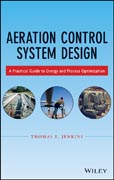
Taking an integrated, cross–disciplinary approach to this critical process, Aeration Control System Design comprehensively addresses the concept and system design of aeration activated wastewater treatment. Author Thomas E. Jenkins, a veteran in the field, covers complete treatment of aeration system controls, processes, and instrumentation and includes a theoretical and mathematical treatment of case histories, complete with design procedures and analysis methodology. Equations, charts, figures, and diagrams are used extensively throughout, making this a vital resource for civil/environmental engineers, mechanical engineers, and electrical/instrumentation engineers. INDICE: Preface xi Acknowledgments xiii List of Figures xv List of Tables xxi 1 Introduction 1 1.1 Basic Concepts and Objectives / 2 1.2 Safety / 9 1.3 The Importance of an Integrated Approach / 10 1.4 Importance of Operator Involvement / 13 1.5 The Benefits of Successful Aeration Process Automation / 14 1.5.1 Energy Cost Reduction / 14 1.5.2 Treatment Performance / 18 1.5.3 Improved Equipment Life / 18 Example Problems / 19 2 Initial System Assessment 21 2.1 Define Current Operations / 24 2.1.1 Energy Cost / 25 2.1.2 Energy Consumption Patterns / 29 2.1.3 Influent and Effluent Process Parameters / 35 2.1.4 Treatment Performance / 36 2.2 Evaluate Process and Equipment / 37 2.3 Benchmark Performance / 40 2.4 Estimate Potential Energy Savings and Performance Improvement / 42 2.5 Prepare Report / 45 Example Problems / 47 3 Aeration Processes 49 3.1 Process Fundamentals / 49 3.1.1 Peripheral Equipment and Processes / 55 3.1.2 BOD Removal / 62 3.1.3 Nitrification / 66 3.1.4 Denitrification / 67 3.2 Loading Variations and Their Implications / 68 3.3 Process Limitations and Their Impact on Control Systems / 70 Example Problems / 74 4 Mechanical and Diffused Aeration Systems 77 4.1 Oxygen Transfer Basics / 78 4.2 Types of Aerators / 87 4.2.1 Mechanical Aerators / 88 4.2.2 Mechanical Aeration Control Techniques / 90 4.2.3 Diffused Aeration / 95 4.2.4 Diffused Aeration Control Techniques / 103 4.3 Savings Determinations / 106 Example Problems / 111 5 Blowers and Blower Control 113 5.1 Common Application and Selection Concerns / 114 5.1.1 Properties of Air / 114 5.1.2 Effect of Humidity / 119 5.1.3 Pressure Effects / 123 5.1.4 Common Performance Characteristics / 125 5.2 Positive Displacement Blowers and Control Characteristics / 134 5.2.1 Types and Characteristics / 134 5.2.2 Lobe Type PD Blowers / 134 5.2.3 Screw Blowers / 138 5.2.4 Control and Equipment Protection Considerations / 141 5.3 Dynamic Blowers / 143 5.3.1 Types and Characteristics / 144 5.3.2 Multistage Centrifugal Blowers / 150 5.3.3 Geared Single Stage Centrifugal Blowers / 152 5.3.4 Turbo Blowers / 154 5.3.5 Control and Protection Considerations / 155 Example Problems / 157 6 Piping Systems 161 6.1 Design Considerations / 162 6.1.1 Layout / 162 6.1.2 Pipe Size / 172 6.1.3 Pipe Material / 174 6.2 Pressure Drop / 178 6.3 Control Valve Selection / 182 Example Problems / 187 7 Instrumentation 191 7.1 Common Characteristics and Electrical Design Considerations / 192 7.2 Pressure / 202 7.3 Temperature / 205 7.4 Flow / 209 7.5 Analytic Instruments / 216 7.5.1 Dissolved Oxygen / 217 7.5.2 Offgas Analysis / 221 7.5.3 pH and ORP / 224 7.6 Motor Monitoring and Electrical Measurements / 224 7.7 Miscellaneous / 226 Example Problems / 230 8 Final Control Elements 233 8.1 Valve Operators / 234 8.2 Guide Vanes / 238 8.3 Motor Basics / 239 8.4 Motor Control / 247 8.5 Variable Frequency Drives / 251 Example Problems / 259 9 Control Loops and Algorithms 261 9.1 Control Fundamentals / 264 9.1.1 Discrete Controls / 264 9.1.2 Analog Control / 267 9.1.3 Proportional–Integral–Derivative / 271 9.1.4 Deadband Controllers / 274 9.1.5 Floating Control / 276 9.2 Dissolved Oxygen Control / 280 9.3 Aeration Basin Air Flow Control / 287 9.4 Pressure Control / 288 9.5 Most–Open–Valve Control / 291 9.6 Blower Control and Coordination / 293 9.7 Control Loop Timing Considerations / 302 9.8 Miscellaneous Controls / 303 Example Problems / 305 10 Control Components 309 10.1 Programmable Logic Controllers / 310 10.1.1 System Architecture / 314 10.1.2 Program Structure / 315 10.1.3 Communications Networks / 318 10.1.4 Accommodating Instrument Inaccuracy and Failure / 322 10.2 Distributed Control Systems / 323 10.3 Human Machine Interfaces / 323 10.3.1 Supervisory Control and Data Acquisition / 325 10.3.2 Touchscreens / 327 10.4 Control Panel Design Considerations / 328 Example Problems / 330 11 Documentation 333 11.1 Specification Considerations / 335 11.2 Data Lists / 338 11.3 Process and Instrumentation Diagrams / 341 11.4 Ladder and Loop Diagrams / 342 11.5 One–Line Diagrams / 344 11.6 Installation Drawings / 345 11.7 Loop Descriptions / 347 11.8 Operation and Maintenance Manuals / 348 Example Problems / 349 12 Commissioning 351 12.1 Inspection / 354 12.2 Testing / 357 12.3 Tuning / 361 12.4 Training / 365 12.5 Measurement and Verification of Results / 368 Example Problems / 369 13 Summary 371 13.1 Review of Integrated Design Procedure / 371 13.2 Potential Problem Areas / 374 13.3 Benefits / 375 Example Problems / 375 Appendix A: Example Problem Solutions 377 Appendix B: List of Equations and Variables 447 Bibliography 485 Index 487
- ISBN: 978-1-118-38998-0
- Editorial: Wiley–Blackwell
- Encuadernacion: Cartoné
- Páginas: 514
- Fecha Publicación: 10/01/2014
- Nº Volúmenes: 1
- Idioma: Inglés
